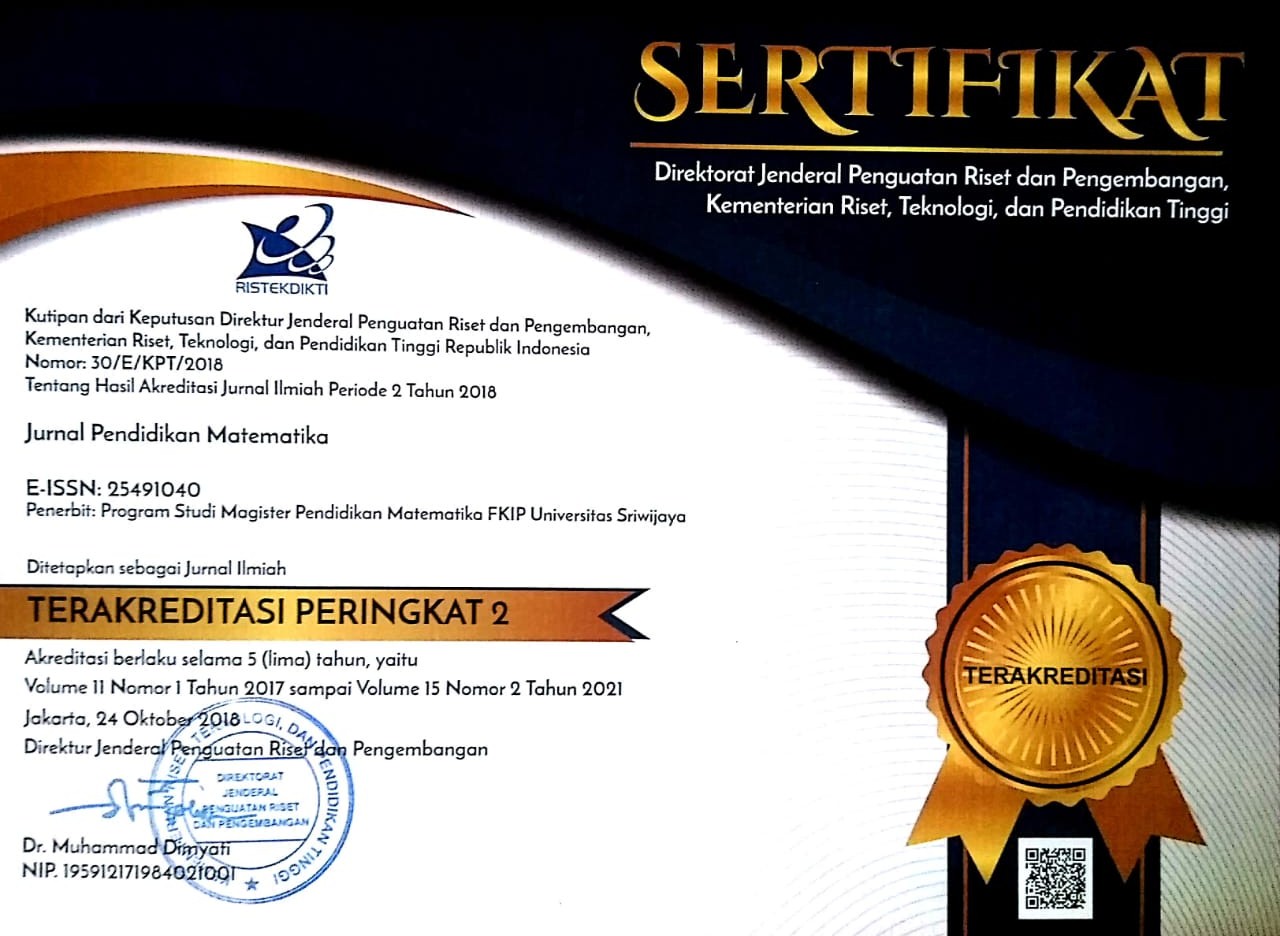Improving PISA-Like Questions Through Trialmusi Video Context: LRT, Damri and Transmusi
Abstract
The aims of this study were (1) to generate PISA mathematics quetions of uncertaint context with the integrated data from LRT, Damri and Transmusi (Trialmusi). (2) is there any potential effect from PISA mathematics questions of uncertain context with the integrated data from LRT, Damri and Transmusi (Trialmusi) towards students’ mathematical literacy abilities of junior high school students. The subjects of this research are the students of junior high school number 1 Palembang. This research applied design research with development study type, with 2 steps, preliminary and formative evaluaions steps. In preliminary step, there were analazying the subject research, curriculum, PISA framework, and designing instrumental questions. In formative evaluation step, there were self evaluation, expert reviews and one to one, small group and field test. The data collection in this research apllied walk trough, documentation, observation, interview and test. This research generated PISA math questions of uncertain context. With the valid and practical integrated data from trialmusi. The validation came from the result of validation assessment, which were from context, construct, language and one to one students’ assessment. Practical came from the result of student understanding towards small group question. Then from the students’ answers in the field test steps.
Keywords
Full Text:
PDFReferences
Batubara, H, H., & Ariani D, N. (2016). Using video as a medium for learning mathematics at SD / MI [in Bahasa]. Jurnal Muallimuna, 2(1), 47-66. http://dx.doi.org/10.31602/muallimuna.v2i1.741.
Fadhli, M. (2015). Development of video-based learning media for class iv elementary schools [in Bahasa]. Jurnal Dimensi Pendidikan dan Pembelajaran, 3(1), 24-29. http://dx.doi.org/10.24269/dpp.v3i1.157.
Jurnaidi & Zulkardi. (2014). Developing of PISA model problem on change and relationship content to know the mathematical reasoning ability of junior high school students [in Bahasa]. Jurnal Pendidikan Matematika, 8(1), 25-42. http://dx.doi.org/10.22342/jpm.8.1.1860.25-42.
Kamaliyah, Zulkardi, & Darmawijoyo. (2013). Developing the sixth level of PISA like mathematics problem for secondary school students. Journal on Mathematics Education, 4(1), 9-28. https://doi.org/10.22342/jme.4.1.559.9-28.
Kemendikbud. (2013). Regulation of the Minister of Education and Culture number 68 of 2013 concerning the basic framework and structure of the junior high school / madrasah tsanawiyah curriculum [in Bahasa]. Jakarta: Kemendikbud.
Kemendikbud. (2016). Improvement and achievements of Indonesia's PISA increasing [in Bahasa]. Retrieved from https://www.kemdikbud.go.id/.
Murtiyasa, B. (2015). Global era mathematics learning challenges [in Bahasa]. Proceeding of The Thirteen National Seminar HUT FKIP Mathematics.
Novita, R., Zulkardi, & Hartono, Y. (2012). Exploring primary student’s problem-solving ability by doing tasks like PISA’s question. Journal on Mathematics Education, 3(2), 133-150. https://doi.org/10.22342/jme.3.2.571.133-150.
OECD. (2016). PISA 2015 result (volume 1): Excellence and equity in education. Paris: OECD Publishing.
OECD. (2016). PISA 2015 Assessment and analytical framework: Science, reading, mathematic and financial literacy. Paris: OECD Publishing.
OECD. (2014). PISA 2012 results: What students know and can do, student performance in mathematics, reading and science volume 1. Paris: OECD Publishing.
Sari, E.F.P. (2015). Developing of PISA Model mathematical problem to know students' arguments in junior high schools [in Bahasa]. Jurnal Pendidikan Matematika, 9(2), 124-147. http://dx.doi.org/10.22342/jpm.9.2.2429.124 – 147.
Shiel, G., Perkins, R., Close, S., & Oldham, E. (2007). PISA mathematics: A teacher’s guide. Dublin: Stationery Office.
Stacey, K. (2010). Mathematical and scientific literacy around the world. Journal of Science and Mathematics, 33(1), 1-16.
Tessmer, M. (1993). Planning and conducting formative evaluations. London: Kogan Page.
Wijaya, A., Heuvel-Panhuizen, M.v.d., Doorman, M., & Robitzsch, A. (2014). Difficulties in solving context-based (PISA). Journal The Mathematics Enthusiast, 11(3), 555-584.
Zuhra, R. (2015). Analysis of student strategies in solving PISA problems on uncertainty and data content in students of class VIII MTsN model Banda Aceh. Thesis. Banda Aceh: Universitas Syiah Kuala.
Zulkardi, & Kohar, A.,W. (2018). Designing PISA-like mathematics tasks in Indoesia: Experiences and challenges. Journal of Physics: Conf.Series 947 012015. DOI: https://doi.org/10.1088/1742-6596/947/1/012015.
Zulkardi. (2006). Formative Evaluation: What, why, when, and how. Retrived from http://www.oocities.org/zulkardi/books.html.
Zulkardi. (2005). Mathematics education in Indonesia: Some problems and solution efforts [in Bahasa]. Inauguration Speech as Permanent Professor in the Field of Mathematics Education at FKIP Sriwijaya University.
DOI: https://doi.org/10.22342/jpm.15.1.11989.91-102
Jl. Srijaya Negara, Bukit Besar
Palembang - 30139 Indonesia
Jurnal Pendidikan Matematika is licensed under a Creative Commons Attribution-NonCommercial-ShareAlike 4.0 International License.
Indexed in:


